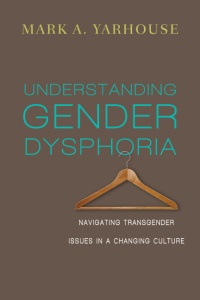Bert and Faye had been married some 30 years when they came to my office for a consultation. Each of their three children (2 biological and one adopted) had been out of the house now for a couple of years, two were married, and one was now expecting their first grandchild. The reason they came for a consultation was Bert’s relatively recent (within the past 3 years) revelation to Faye that he was a woman. This was really difficult for Faye to process. She would look at me and say, “Does this make any sense to you at all?” In a private meeting, Bert shared with me that he had known about his gender dysphoria for many years before he disclosed to Faye, but he had not known what it was before then. He thought he was losing his mind. He did not have a name for what he experienced, and that lack of understanding only intensified his confusion and distress. He has begun cross-dressing intermittently by wearing female undergarments. He is interested in presenting as female but he and Faye agree that doing so locally would not be advisable. He has considered doing so on business trips, which he takes about every 3-4 weeks to larger cities around the country. He believes that this level of cross-gender identification will likely help him manage his dysphoria by helping him express who he experiences himself to be.
 As the story of Bert and Faye exemplifies, the challenges in adult experiences of gender dysphoria are numerous and complex. The last post in our series addressed gender dysphoria in childhood and adolescence, including some of the controversies surrounding prevention and intervention. In this post we reflect on what happens in cases in which gender dysphoria does not resolve–in cases in which the child or adolescent is now an adult who reports an ongoing incongruence between their biological sex and their gender identity. What happens to this person? How does the story end?
As the story of Bert and Faye exemplifies, the challenges in adult experiences of gender dysphoria are numerous and complex. The last post in our series addressed gender dysphoria in childhood and adolescence, including some of the controversies surrounding prevention and intervention. In this post we reflect on what happens in cases in which gender dysphoria does not resolve–in cases in which the child or adolescent is now an adult who reports an ongoing incongruence between their biological sex and their gender identity. What happens to this person? How does the story end?
In researching answers to these questions, I was surprised to learn that in many cases (an estimated 50% of cases), we actually do not know the answers to these questions. In other words, many people have unresolved outcomes in which we just do not know what happens to a person (again, as many as half of all cases).
Of cases that are tracked and where we do know what happens, it is typically understood that there are three pathways. The first path is to attempt to live one’s gender role and identity in keeping with one’s biological sex. The person may feel gender dysphoric, but they live as their birth sex and corresponding gender identity/role and adopt a lifestyle that reflects that. In the case of Bert and Faye, Bert shared that he would have liked to have experienced some kind of resolution like this, especially if it meant he and Faye could stay married and avoid predictable social stigma in their rather small and conservative hometown. Faye definitely wanted this resolution.
The second path is to engage in cross-gender behavior intermittently. Bert did try this for several years. For a biological male, this might mean growing his hair out longer, wearing make-up occasionally, and cross-dressing either on the weekends or wearing female undergarments during the day to manage the dysphoria. Think of this as a continuum. The extent of cross-dressing behavior varies considerably and typically reflects the degree of dysphoria and how successfully such cross-dressing behaviors reduces or makes the dysphoria more manageable.
The third path is to adopt a cross-gender role and identity. This may or may not involve hormonal treatment and sex reassignment surgery. Many people do not pursue these steps for a variety of reasons. In any case, the last path is reflected in those who cross-gender identify (or adopt the gender identity and role of the opposite sex). Throughout this whole process and again with the discussion of hormonal therapy and/or surgery, most mental health professionals reference the widely-recognized Standards of Care of the World Professional Association for Transgender Health (WPATH; formerly referred to in the literature as the Harry Benjamin International Gender Dysphoria Standards of Care).
If you are interested in this topic, you might be interested in the previous posts in this series. Also, there is so much more to say about these potential pathways and research on outcomes. Learn more by reading, Understanding Gender Dysphoria, forthcoming from InterVarsity Press Academic. The publisher recently released an excerpt if you would like to check it out here.

Thanks for your (always helpful) thoughts on such complicated matters! There’s no one doing the kind of work that you do. Any thoughts about ethical and spiritual norms that might guide people with gender dysphoria regarding which of the three identified options are live options for followers of Christ?
Maybe the real question is this….Is Bert really a woman OR have the chemicals in Bert’s body confused him as to what reality really is? The same with homosexuality…Is it possible that the chemicals can confuse a person so much and for so long that they really begin to believe, act and feel homosexual? Since these issues both have a physical “sexualness” and an emotional aspect to them, what if body chemicals were altered? Would this drastically change the outcome?